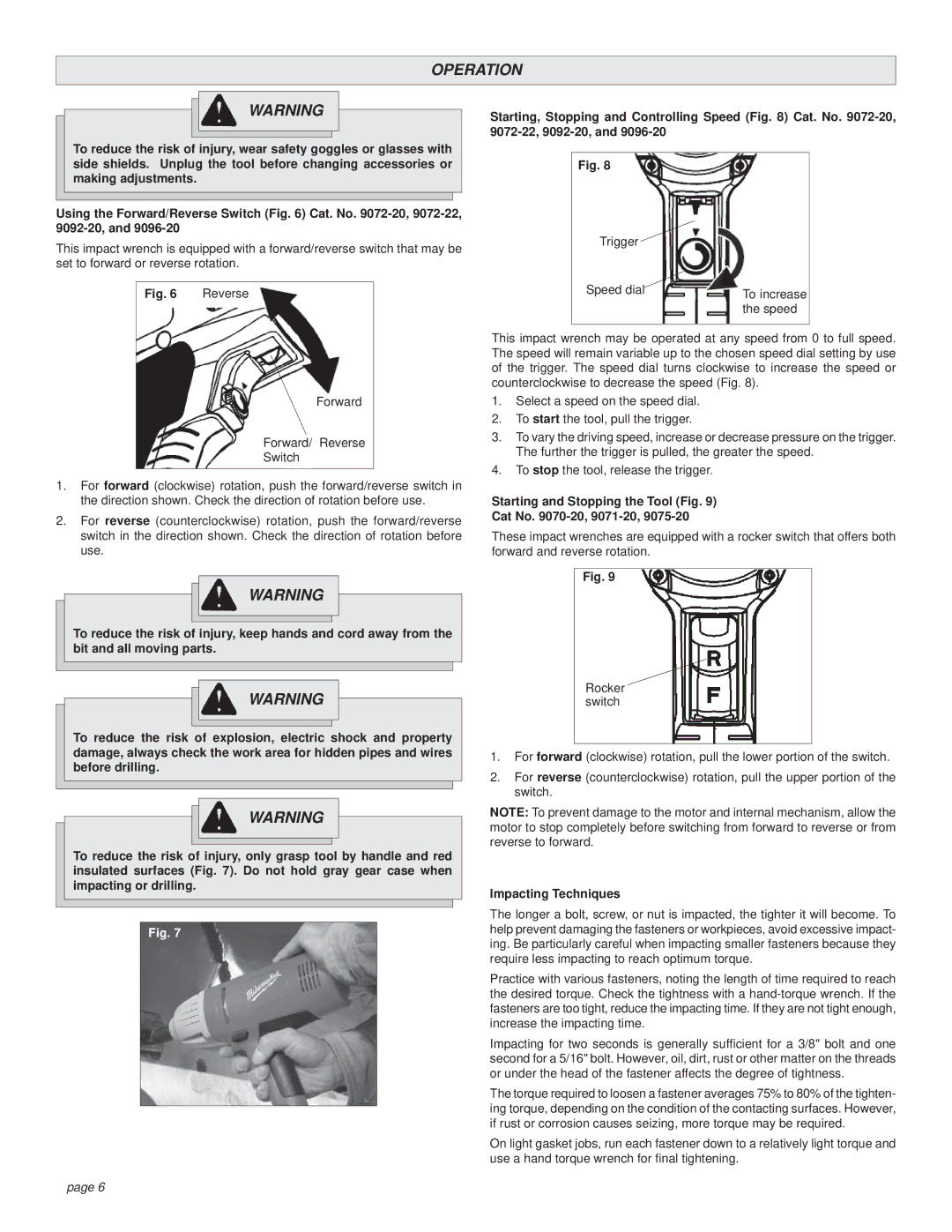
OPERATION
WARNING
To reduce the risk of injury, wear safety goggles or glasses with side shields. Unplug the tool before changing accessories or making adjustments.
Using the Forward/Reverse Switch (Fig. 6) Cat. No.
This impact wrench is equipped with a forward/reverse switch that may be set to forward or reverse rotation.
Fig. 6 | Reverse |
Forward
Forward/ Reverse
Switch
1.For forward (clockwise) rotation, push the forward/reverse switch in the direction shown. Check the direction of rotation before use.
2.For reverse (counterclockwise) rotation, push the forward/reverse switch in the direction shown. Check the direction of rotation before use.
WARNING
To reduce the risk of injury, keep hands and cord away from the bit and all moving parts.
WARNING
To reduce the risk of explosion, electric shock and property damage, always check the work area for hidden pipes and wires before drilling.
Starting, Stopping and Controlling Speed (Fig. 8) Cat. No.
Fig. 8
Trigger |
|
Speed dial | To increase |
| the speed |
This impact wrench may be operated at any speed from 0 to full speed. The speed will remain variable up to the chosen speed dial setting by use of the trigger. The speed dial turns clockwise to increase the speed or counterclockwise to decrease the speed (Fig. 8).
1.Select a speed on the speed dial.
2.To start the tool, pull the trigger.
3.To vary the driving speed, increase or decrease pressure on the trigger. The further the trigger is pulled, the greater the speed.
4.To stop the tool, release the trigger.
Starting and Stopping the Tool (Fig. 9)
Cat No. 9070-20, 9071-20, 9075-20
These impact wrenches are equipped with a rocker switch that offers both forward and reverse rotation.
Fig. 9
Rocker switch
1.For forward (clockwise) rotation, pull the lower portion of the switch.
2.For reverse (counterclockwise) rotation, pull the upper portion of the switch.
WARNING
To reduce the risk of injury, only grasp tool by handle and red insulated surfaces (Fig. 7). Do not hold gray gear case when impacting or drilling.
Fig. 7
NOTE: To prevent damage to the motor and internal mechanism, allow the motor to stop completely before switching from forward to reverse or from reverse to forward.
Impacting Techniques
The longer a bolt, screw, or nut is impacted, the tighter it will become. To help prevent damaging the fasteners or workpieces, avoid excessive impact- ing. Be particularly careful when impacting smaller fasteners because they require less impacting to reach optimum torque.
Practice with various fasteners, noting the length of time required to reach the desired torque. Check the tightness with a
Impacting for two seconds is generally sufficient for a 3/8" bolt and one second for a 5/16" bolt. However, oil, dirt, rust or other matter on the threads or under the head of the fastener affects the degree of tightness.
The torque required to loosen a fastener averages 75% to 80% of the tighten- ing torque, depending on the condition of the contacting surfaces. However, if rust or corrosion causes seizing, more torque may be required.
On light gasket jobs, run each fastener down to a relatively light torque and use a hand torque wrench for final tightening.
page 6
